Nokia C5-03 Review
Nokia C5-03
The Nokia C5-03 may be a smartphone, but dated software means it's not a clever choice for most buyers.
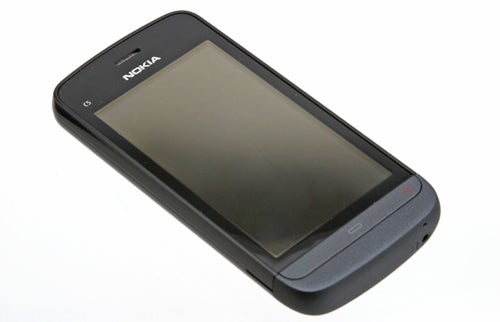
Verdict
Pros
- Relatively high-resolution screen
- Built-in podcast downloader
- 3.5mm headphone jack
Cons
- Dated OS
- Resistive touchscreen
- No LED flash
Key Specifications
- Review Price: £179.99
- Symbian S60 operating system
- 5-megapixel camera
- 3.2-inch 360x640 pixel screen
- 3.5mm headphone jack
- 2GB bundled microSD card
The Nokia C5-03 is clinging onto the past with all its might. Nokia has just teamed-up with Microsoft to pump out its own Windows Phone handsets, but the Nokia S5-03 is stuck with the Symbian operating system. It’s not the Symbian^3 OS released in October 2010 alongside the Nokia N8 either – this is Symbian S60 version 5, used in the Nokia N97 way back in the prehistoric age of 2009.
Symbian S60 isn’t just old, it’s the cremated remains of a smartphone system held together with sticky tape and hair spray, and it pales in comparison to iOS and Android. In a budget phone like the Nokia C5-03, however, it doesn’t feel entirely out of place. The phone is available for free on contracts of £15 a month or more, or SIM-free for around £180.
Nokia hasn’t tried too hard to convince us this is anything but a budget smartphone through its build. The Nokia C5-03 has an all-plastic body and, apart from a textured end-cap, it’s super-shiny. Out of the box this heavy dose of plastic is clearly evident, but it’s only going to get worse with use as this finish shows up every blemish, scratch and scrape whenever the phone catches the light. In fairness, the actual design is quite smart but we just fear it won’t remain looking that way for any length of time. 2010’s Nokia C3 proved that Nokia can produce a phone with a top design and a rock-bottom price, but it hasn’t pulled off the same trick here. 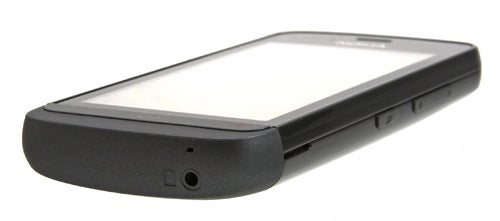
On the top of the handset, there are the now-standard 3.5mm headphone and micro USB ports, and the right hand-side is home to the volume rocker and lock button. The only odd addition to the Nokia C5-03’s body sits on the handset’s bottom – the tiny cylindrical Nokia charge socket, now nearing extinction as micro USB continues to dominate mobile charging. The micro USB socket of the C5-03 can also be used to charge the phone, but using the dedicated charging socket is quicker. We found charging with a dedicated micro USB charger snappy enough, but one isn’t bundled here – just a proprietary charger and USB data transfer cable.
Questionable aesthetics and blast-from-the-past features aside, the Nokia C5-03 isn’t entirely out-of-date. It has a 600MHz ARM 11 processor, on-par with the majority of budget smartphones and not much slower than the Nokia N8’s 680MHz CPU. That said, day-to-day navigation is rarely lag-free, but we’d attribute that’s more the inherent interface design of the Symbian S60 system than a lack of power in the Nokia C5-03. All told, the lag is similar to what you’d see in an Android 2.1 phone with a similar 500-600MHz processor.
The Nokia C5-03 uses a vanilla version of the S60 Symbian OS. This affords you a single home screen, which can only be lightly customised. There are four user-defined shortcuts at the bottom, a contacts bar, clock, email notification bar and a Wi-Fi control bar. These can be chopped-out if you want to give the Nokia C5-03 a minimalist look, but customisation comes in the form of checking and unchecking tick boxes, not dragging these elements around freely.
The limitations of Symbian S60’s home screen means the main apps menu is where you’ll be heading most of the time, unless you’re only going to use the Nokia C5-03 for the most basic of functions. This three icon-wide menu houses core features like the Settings menu and all your apps, with downloaded apps dumped into a separate Applications folder.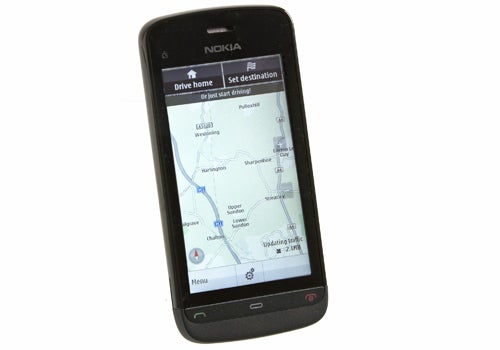
The Nokia C5-03 comes with Ovi Maps navigation software pre-installed, along with uninspiring app standards like a unit converter, calculator and Dictionary, but for any serious app action a trip to the Ovi Store is required. The Ovi Store supplies apps for Nokia’s smart and dumb phones, and can be accessed using the Nokia C5-03’s web browser or the built-in Ovi app.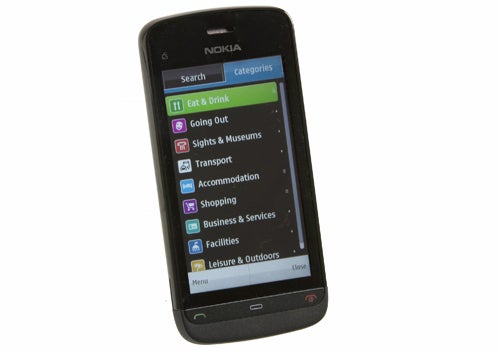
A smattering of Symbian S60 apps match the quality of Android and iPhone equivalents, but a great many are java ports. The vast majority of games in particular are re-workings of feature phone games, characterised by simplistic 2D graphics that have been designed with less high-resolution screens than the C5-03’s in mind. The Symbian apps scene may have been ticking away since before the first iPhone was released, but if you care about apps you’d be much better served by an Android phone – or an iPod Touch partnered with a £25 ultra-budget handset.
As far as it lags behind in apps, Symbian S60 is still a smartphone OS. It has a full web browser, compatible with Flash lite 3.0, and with both Wi-Fi and high-speed HSPA connectivity built in. The browser offers a decent bookmarks system and a “back” function that offers previews of recently-visited pages in thumbnail form, which sounds better than it actually is.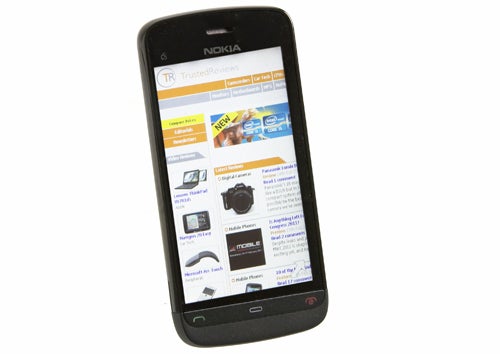
Thanks to the non multi-touch resistive touchscreen of the Nokia C5-03, there’s no pinch-to-zoom feature – a double tap switches between zoomed-in and non-zoom views – and in-page navigation is nowhere near as breezy as on an iPhone or mid-range Android. Like being driven around by an aged cataract-ridden relative, Symbian demands a little patience, but it gets there in the end.
Does Symbian offer any advantages when put up against more up-to-date rivals? For power users, the answer’s no. But the simple home screen structure will appeal to some – but even that crowd’s thinning rapidly.
The Nokia C5-03 uses a 3.2-inch 360×640 pixel screen. It’s not an AMOLED model, as seen in the Nokia C7, but it’s sharp, has decent viewing angles and good contrast. As far as budget mobile phone displays go, it’s a winner.
The same can’t be said about the touchscreen. The Nokia C5-03 uses a resistive touchscreen, which senses contact through pressure rather than conduction. This means a stronger prodding action is needed here than on phones equipped with capacitive touchscreens, such as the similarly-priced Sony Ericsson Xperia X8. The result is a less responsive feel, leading to navigation that seems sluggish.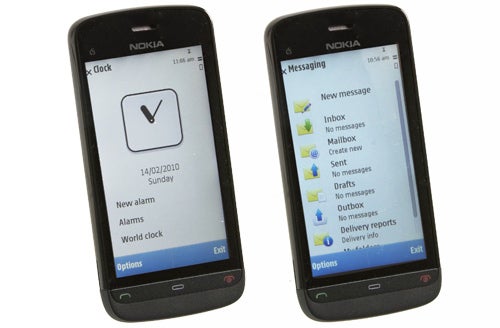
Partner the Nokia C5-03 with a stylus, or even a biro, and the resistive touchscreen performs better, but such a thing isn’t included here. A good resistive screen is more accurate than a finger-operated capacitive model when used with a stylus, but resistive touchscreens aren’t used to their strengths anymore – they’re used simply as a cheaper alternative to a capacitive model. Taste the compromise, readers. Bitter, isn’t it?
In order to combat the effects of the clunky touchscreen, the Nokia C5-03 limits text input to a T9 pad, rather than a full Qwerty, when used in portrait mode. Handwriting recognition is also on offer, but as a gimmicky “mobile innovation” of almost half a decade ago, we can’t imagine many will use it.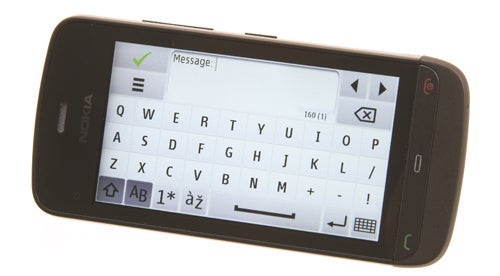
Although slower than using a decent portrait Qwerty keyboard, such as that of the 3.2-inch screen HTC Legend, the large T9 buttons make input accurate, if slow. Switching to landscape and using the full virtual Qwerty is preferable though.
Resistive screens were once the staple of the budget touchscreen phone, but with devices like the Samsung Galaxy Europa and HTC Wildfire having brought quality capacitive touch panels to the same price point, the Nokia C5-03 once again looks behind the times. Although responsive and accurate for a screen of its type, it slows down everyday navigation and web browsing significantly.
The Nokia C5-03 offers a 5-megapixel camera – the highest megapixel count you’ll currently find at this low-end price point. Although this spec may match the iPhone 4 – one of the better camera phones on the market – the Nokia C5-03 is no photographic star.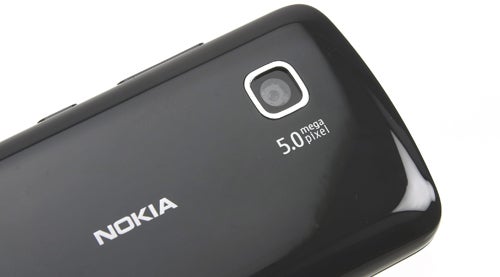
It uses a fixed focus system, giving you no control over what part of your image is the sharpest. In practice, this works fine for daylight shots where your subject is in the background, but is useless for close-ups. There’s also no flash, so once the sun goes away, so does your ability to take worthwhile photos. In optimum conditions, the Nokia C5-03 produces shots worth posting on Facebook, but with detail lacking and a limited ability to cope with intense light sources, we can’t imagine many of your shots would be worth a print-out.
When the lack of flash and underpowered sensor putting the C5-03’s camera versatility on lock-down, it’s surprising that the phone gives you a decent amount of control over the camera settings. There are five scene modes, plus an extra user-defined option, alongside controls for colour tone, white balance, exposure, light sensitivity, contrast and sharpness. A 4x digital zoom is available for both stills and video, but as with any digital zoom this will degrade the quality of your results.
Video capture is limited 640×480 resolution, with mono sound. As with stills, the video quality is just about good enough to spread over the web to your less-discerning social networking chums but nothing more.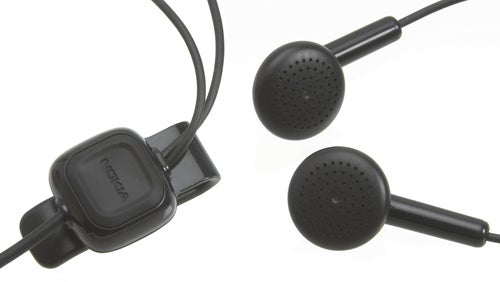
The Nokia C5-03’s 3.2in screen is arguably too small to watch anything but the occasional YouTube clip on, and bare-bones video file support does nothing to convince us otherwise. DivX and Xvid files won’t play, leaving you with the standard H.263, H.264 and MP4 format compatibilities, designed to get most web vids playing without problems.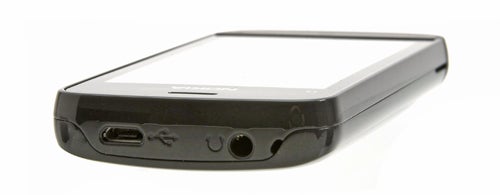
The phone fares better with music, offering a decent player app, FM radio and a nifty podcast app that lets you download casts over 3G or Wi-Fi from your handset. The output level is low though, with maximum volume unlikely to be enough for some when on public transport, or in other noisy environments. It seems as though you’ll also need a converter to use your standard earphones in the Nokia C5-03 – although music played with our non-bundled test earphones, there seemed to be an issue with playing-back the full stereo channel.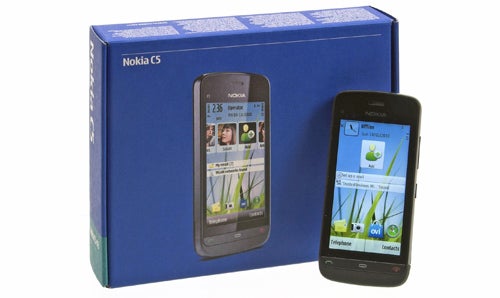
The Nokia C5-03 comes with a 2GB memory card to build upon the insignificant 40MB of internal storage, but most of you thinking of using this phone as an MP3 player-replacement would probably want to upgrade to a larger card. A remote control widget appears on the home screen when music is playing too – a nice multi-tasking touch that convinces us this phone would make a decent music buddy. This does little to differentiate the Nokia C5-03 over its rivals though, as all but the cheapest phones these days make competent digital music players.
”’Verdict”’
In budget smartphone territory, the Nokia C5-03’s Symbian S60 OS doesn’t feel as out of its depth as it did when rolling with the high-end, but it still feels way past its prime. Add the also-archaic resistive touchscreen and the Nokia C5-03 starts to sound more out-of-date than power suits and tie-dyed T-shirts.

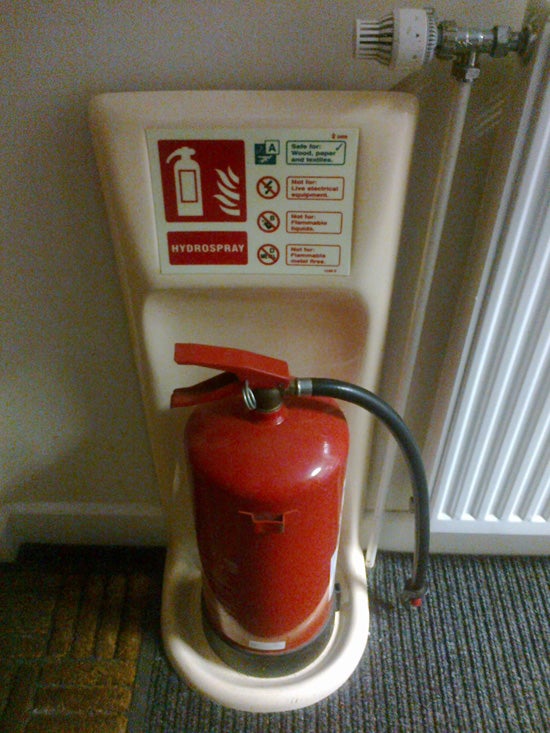


How we test phones
We test every mobile phone we review thoroughly. We use industry standard tests to compare features properly and we use the phone as our main device over the review period. We’ll always tell you what we find and we never, ever, accept money to review a product.
Trusted Score
Score in detail
-
Performance 5
-
Design 6
-
Value 5
-
Features 6
General
| Operating System | Symbian OS |
| Height (Millimeter) | 105.8mm |
| Width (Millimeter) | 51mm |
| Depth (Millimeter) | 13.8mm |
| Weight (Gram) | 93g |
| Available Colours | White, Black, Lime green, Blue |
Display
| Screen Size (inches) (Inch) | 3.2in |
| Screen Resolution | 360x640 |
| Touchscreen | Yes |
Battery
| Talk Time (Minute) | 270m |
| Standby Time (Hour) | 576hr |
Storage
| Internal Storage (Gigabyte) | 2GB |
| Camera (Megapixel) | 5 Megapixel |
| Front Facing Camera (Megapixel) | No Megapixel |
| Camera Flash | No |
Connectivity
| Bluetooth | Yes |
| WiFi | Yes |
| 3G/4G | Yes |
| 3.5mm Headphone Jack | Yes |
| Charging/Computer Connection | microUSB |
Processor and Internal Specs
| CPU | 600MHz ARM 11 |
Misc
| App Store | Ovi Store |
| GPS | Yes |


